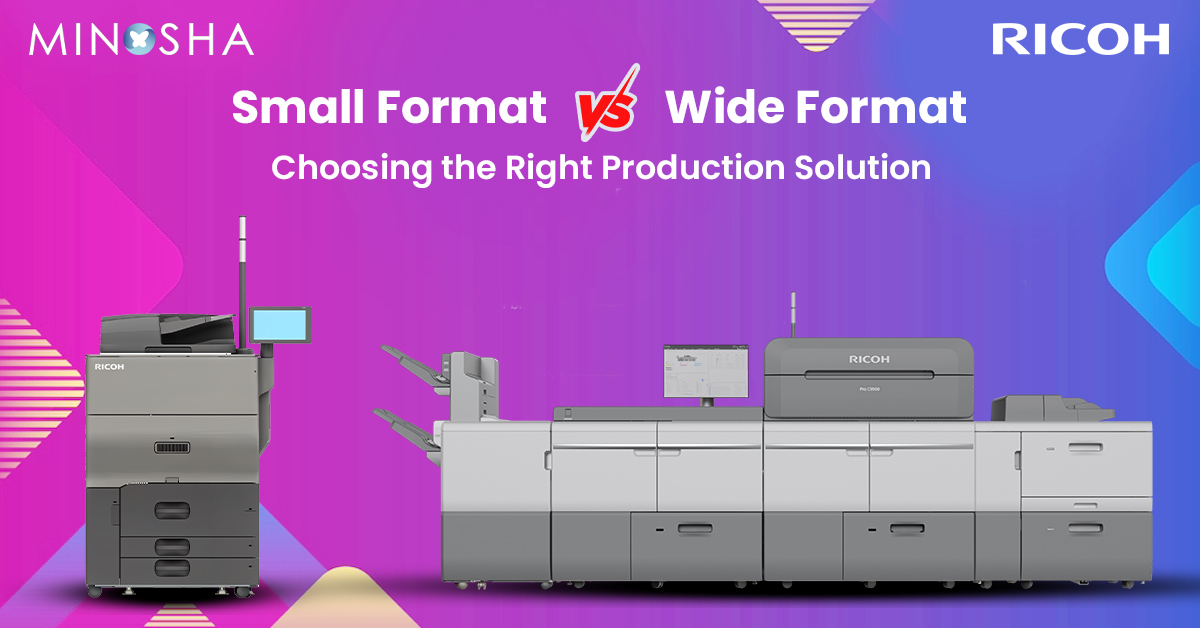
Choosing the right printer for your business can feel overwhelming. Should you go with a small format printer that handles regular-sized paper, or invest in a wide format machine that prints on large sheets? This decision affects your costs, the types of jobs you can take on, and how much money you can make. Let’s break down everything you need to know to make the best choice for your business.
Small format printing means using printers that work with regular paper sizes – think standard letter paper (8.5″ x 11″), legal size, and up to about 13″ x 19″ sheets. These machines are built to print lots of pages quickly and are perfect for everyday business needs.
Small format printers work great for printing things like business documents, brochures, flyers, letters, and reports. A good production printer in this category can print thousands of pages every hour without losing quality. They can handle different types of paper too – from thin copy paper to thick cardstock.
These printers are popular with print shops, offices, and businesses that send out lots of mail. They’re reliable workhorses that keep running day after day, making them perfect for high-volume jobs where you need consistent results.
Wide format printing uses much bigger printers that can handle paper and materials that are 24 inches wide or even wider – some go up to several feet across. These machines are designed to create large prints like banners, posters, signs, and vehicle wraps.
The biggest advantage of wide format printing is that it lets you create eye-catching displays that grab attention. Think about the big banners you see at stores, outdoor billboards, or the graphics wrapped around delivery trucks. You simply can’t make these with a regular-sized printer.
Wide format printers can work with many different materials beyond paper – vinyl, fabric, canvas, and special films. This flexibility opens up many business opportunities that small format printing just can’t handle.
Both small and wide format printers can produce excellent results, but they’re designed for different purposes. Small format printers focus on sharp text and consistent colors for documents people will read up close. They’re great at printing the same quality page after page, even during long print runs.
Wide format printers put more emphasis on bright, vibrant colors and the ability to print on unusual materials. Since people usually view wide format prints from a distance – like posters on a wall – the quality requirements are different. The colors need to pop and stay bright even when printed on different materials.
Both types of printers have gotten much better over the years, and today’s best production printers in both categories can deliver professional results that will impress your customers.
Small format printers are speed champions. They can crank out thousands of pages per hour, making them perfect for big jobs like printing newsletters for an entire company or thousands of direct mail pieces. If your business does a lot of high-volume work with regular-sized documents, small format is usually the way to go.
Wide format printers work more slowly because they’re dealing with much larger areas and often more complex graphics. However, they make up for slower speed with higher value per print. A single wide format banner might bring in as much profit as hundreds of regular documents.
The key is matching the printer’s speed to your business needs. If you print thousands of pages daily, speed matters a lot. If you print fewer pieces but they’re large and valuable, slower speed might be perfectly fine.
The upfront cost of printers varies widely in both categories. Small format production printers can range from a few thousand dollars to over $100,000 for high-end models. Wide format printers also span a wide price range, with entry-level models starting around $5,000 and professional units costing much more.
But the purchase price is just the beginning. You also need to think about ongoing costs like ink, paper, and maintenance. Small format printers typically have lower ink costs per page, but wide format prints often sell for much higher prices, potentially giving you better profit margins.
Don’t forget about space requirements either. Wide format printers take up more room and often need special ventilation. Small format units are more compact and easier to fit into existing office spaces.
Small format printing opens doors to steady, reliable business opportunities. You can offer services like business cards, letterheads, brochures, direct mail, reports, and booklets. Many of these are repeat services – once you land a client, they’ll likely need similar work regularly.
Wide format printing opens up completely different markets. You can create trade show displays, retail signs, vehicle graphics, outdoor banners, wall murals, and architectural drawings. These jobs often pay more per piece, but they might not come as frequently.
Some successful print businesses focus on one format, while others invest in both to serve a wider range of customers. Ricoh production printers and other major brands offer solutions in both categories, so you can often work with the same manufacturer regardless of which path you choose.
Both types of printers need regular maintenance to keep running smoothly, but the requirements are different. Small format printers usually need more frequent attention because they run more pages, but the maintenance is often simpler and faster.
Wide format printers might need less frequent service, but when they do need attention, it can be more complex because of their size and the variety of materials they handle. The specialized inks and printheads in wide format machines can also be more expensive to replace.
Consider the availability of service in your area. Small format printers are more common, so finding qualified technicians is usually easier. Wide format equipment might require specialized service that could take longer to arrange.
The right choice depends on your specific business situation. If you already have steady customers who need lots of regular documents printed quickly, small format makes sense. If you want to break into the signage and display market, wide format is necessary.
Consider starting with the format that matches your immediate market opportunity, then potentially adding the other format later as your business grows. Many successful print operations use both types of equipment to serve different customer needs and maximize their market reach.
Think about your space, budget, and the skills of your team. Both formats can be profitable, but they require different approaches to marketing, pricing, and customer service.
The printing industry continues to evolve, with new technologies making both small and wide format printing more accessible and profitable than ever. Whatever you choose, focus on understanding your customers’ needs and delivering consistent, high-quality results. Success in printing comes from matching the right equipment to the right market opportunity.
Subscribe to our Newsletter for Exclusive Insights and Updates!
